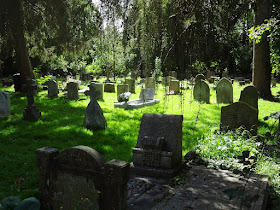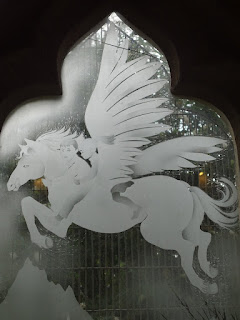Although buses from the centre of Oxford to Headington Quarry are both plentiful and frequent, I decided to walk yesterday, just to make it more challenging. (I was going to say 'more interesting', but the route really isn't interesting at all - all suburban roads!). It took just under an hour, and it only rained twice on the way, which seemed like good going. By the time I got there, the sun was shining beautifully and I was oddly excited - as if making the effort of walking, and having to hunt the place out, made it more like a quest. That can be the only explanation for the fact that I took this entirely unnecessary picture of the sign on the lane leading to the church:

And this one of the sunny lane:

And this one:

'Church open' is one of those signs which delights the visitor's heart; sadly, in this case it proved to be a false hope, a snare and a delusion, if you will. For alas, the church was not open. At least, there was a wedding going on, and from the lusty singing of 'Lord of the Dance' which greeted me when I arrived at half past two, it seemed likely to continue for some time.
So I took this picture of the porch (aren't you glad you can't hear 'Lord of the Dance' while you look at it?):

And this one:

(You'll notice I was trying to avoid standing in front of the doorway!)
And then I went in search of C. S. Lewis' grave, which is in a delightful spot, under a tree:


I really liked how the shadows of the branches fell upon it, and the tree roots had reached out to embrace it:

And how, from a distance, the whiteness of the stone meant that the sun gleamed upon it:

And how the neighbouring grave, overflowing with flowers, seemed to be lending some to Lewis:


Nearby is buried Mrs Moore, the mother of Lewis' friend, who lived with him and his brother at 'The Kilns':

Also buried nearby - and this was a pleasant surprise to me - is a man who was a key figure in the revival of English folk music at the beginning of the twentieth century. William Kimber played the concertina for the Headington Quarry Morris side, who, on Boxing Day 1899, gave Cecil Sharp his first introduction to English folk dance. Sharp noted down his first Morris tunes from Kimber's instruction, and when Sharp began to lecture on folk music, Kimber would demonstrate the music and dances; Sharp said that without Kimber's "practical instruction and capital demonstrations in public, the movement would never have been launched". At the time Morris dancing in England was on the way to extinction, and if it hadn't been for that meeting at Headington Quarry it might well have died out altogether. Through the magic of youtube, you can hear William Kimber playing the concertina here, and his grave is absolutely lovely - look:

The inscription reads 'William (Merry) Kimber, Father of English Morris, 1872-1961' - and yes, that's a concertina! It's beautifully detailed:

Those things beneath are the rows of bells worn by Morris dancers (see here for a picture). I think the stops and straps are my favourite part:

Kimber's grave with Lewis' gleaming in the background:

As the wedding was still going on (they had reached the John Rutter stage of proceedings), I took some more pictures of the outside of the church:




Although it has a medieval look to it, the church was actually built in 1848-9, since Headington Quarry (a settlement which had grown up around the stone quarry, as you probably could have guessed!) then had no church of its own. It was designed by George Gilbert Scott, and fits quietly and unobtrusively in its surroundings; you might easily believe it had been here for a thousand years.
The quiet (broken only by the strains of 'Give me joy in my heart, keep me praising') was shared by an assortment of creatures in the next field:

Random chickens and horses - why not? This is not actually rolling countryside at all (the Oxford bypass is just the other side of the hill) but it feels a lot like it.



Dum-de-dum, waiting, waiting... gosh, weddings are long. The churchyard is small, but there's really nowhere else to go in the vicinity of the church, and having walked so far, I wasn't inclined to give up and go home. But by this time there were some ominous rumbles of thunder and the brief window of glorious sunshine had disappeared. At last the little bell dinged, the wedding party emerged from the church, and the picture-taking process began. I lurked out of sight, trying not to look like Banquo's ghost. Also lurking were various other people who were waiting to see inside, having, like me, made the fatal error of trusting a church website to give accurate opening times. (Never trust a church website! Rookie mistake...)
Then the heavens opened and there was a downpour. It was much worse for the poor wedding people than for me, because I just stood under a tree and got very wet, while they stood outside the porch (why not inside the porch, I couldn't help asking myself) and got very wet, and in their pretty dresses too. I hope you'll understand why I didn't take any pictures at this stage of the proceedings. One by one the wedding people made a dash for it to their cars, and at last there were few enough of them that I thought it wouldn't be rude to try and get into the church. (If they protested, I was planning to make an appeal to them on humanitarian grounds, as soaking wet person to soaking wet person.)
They did not protest, and so finally, after more than an hour of skulking around in the churchyard, I was inside the church. I'll be honest: I was not, by this stage, in quite the right mood to appreciate its beauties, being wet and bored, and annoyed at myself for walking for an hour to get to a place which wasn't going to be open for another hour (again: never trust a church website). I was no longer 'excited Lucy entering the magical land of Narnia', as I had been at the top of the church lane, and more 'fed-up Eustace after a few days on the Dawn Treader'. However, I took pictures anyway:

(I hope you appreciate how I managed to make it look like the church is empty in this photo, although in fact it contained several fellow-skulkers from the churchyard, a variety of church personnel, and a bride.)

The east window is by Ninian Comper.



This was the window I had really come to see, which is near the pew where C. S. Lewis (or G. S. Lewis, if you believe the church leaflet) used to sit:


It was installed in 1991, and the engraved glass depicts various elements from the world of Narnia.









Beautiful! But by this time my wet feet and I were in need of some of Lucy's magic cold-preventing cordial, so I betook myself home. In conclusion: Headington Quarry is very pretty when the sun is shining, but "ware danger", as the Narnians say - by which I mean, rain storms, weddings, and church websites...
"I hope you appreciate ..." you said, and I do! I do appreciate! very much indeed -- thank you!! :)
ReplyDeleteExcellent! I'm glad someone is reading these older posts, it's nice to keep them alive :)
ReplyDeleteDelightful. I enjoyed your pilgrimage and insights!
ReplyDelete